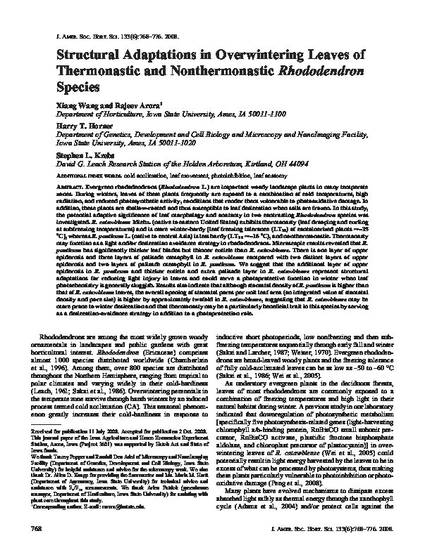
Evergreen rhododendrons (Rhododendron L.) are important woody landscape plants in many temperate zones. During winters, leaves of these plants frequently are exposed to a combination of cold temperatures, high radiation, and reduced photosynthetic activity, conditions that render them vulnerable to photooxidative damage. In addition, these plants are shallow-rooted and thus susceptible to leaf desiccation when soils are frozen. In this study, the potential adaptive significance of leaf morphology and anatomy in two contrasting Rhododendron species was investigated. R. catawbiense Michx. (native to eastern United States) exhibits thermonasty (leaf drooping and curling at subfreezing temperatures) and is more winter-hardy [leaf freezing tolerance (LT50) of containerized plants ≈–35 °C], whereas R. ponticum L. (native to central Asia) is less hardy (LT50 ≈–16 °C), and nonthermonastic. Thermonasty may function as a light and/or desiccation avoidance strategy in rhododendrons. Microscopic results revealed that R. ponticum has significantly thicker leaf blades but thinner cuticle than R. catawbiense. There is one layer of upper epidermis and three layers of palisade mesophyll in R. catawbiensecompared with two distinct layers of upper epidermis and two layers of palisade mesophyll in R. ponticum. We suggest that the additional layer of upper epidermis in R. ponticum and thicker cuticle and extra palisade layer inR. catawbiense represent structural adaptations for reducing light injury in leaves and could serve a photoprotective function in winter when leaf photochemistry is generally sluggish. Results also indicate that although stomatal density of R. ponticum is higher than that of R. catawbiense leaves, the overall opening of stomatal pores per unit leaf area (an integrated value of stomatal density and pore size) is higher by approximately twofold in R. catawbiense, suggesting that R. catawbiense may be more prone to winter desiccation and that thermonasty may be a particularly beneficial trait in this species by serving as a desiccation-avoidance strategy in addition to a photoprotection role.
Available at: http://works.bepress.com/harry-horner/91/

This article is from Journal of the American Society for Horticulture Science 133 (2008): 768. Posted with permission.